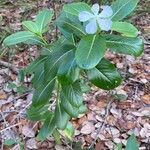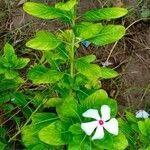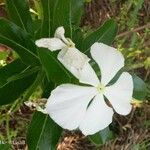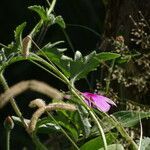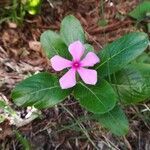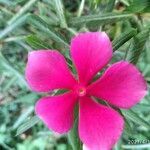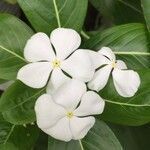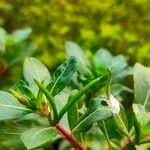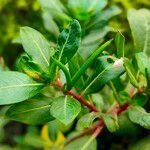Perennial herb or herbaceous shrub, 0.3-0.7(-1.0) m high; multi-stemmed from near woody base. Leaves obovate, oblong or oblanceolate, 40-80 x 10-13 mm; fringe of many colleters in axil. Inflorescences axillary, solitary or paired. Flowers white or pink. Corolla: tube 23-26 mm long, mouth constricted with dense short hairs, widening at point of insertion of stamens; lobes 16-20 mm, apex broadly obtuse almost truncate. Anthers with short blunt lobes at base. Gynoecium apocarpous and bicarpellate. Styles: apex capitate with a translucent frill at base. Flowering time all year, peaking in summer months. Fruit a pair of slightly diverging, cylindrical follicles, sometimes 1 by abortion, 25-35 mm long. Seeds many and small.
Erect, hairy, perennial herb. Petiole < 7 mm long; lamina 3.5-6 × 1-2.5 cm, oblong or obovate-oblong, clothed in short hairs above and below, penninerved with prominent yellowish veins and midrib; base cuneate; apex rounded and mucronulate. Pedicels 1-3 mm long. Calyx c. 6 mm long; lobes linear-subulate, densely hairy. Corolla tube 2-2.5 cm long, hairy, ampliate towards apex where stamens are inserted; limb 3-4 cm diam., deep pink with crimson eye in centre, whitish on reverse; lobes ± obovate, rounded apart from apical mucro, glabrous. Anther sacs 4-6× longer than wide, parallel, close together. Nectary disc = or > ovary. Follicles c. 2.5 cm long, hairy; seeds 1.75-2 mm long, black, oblong.
Herb or small subshrub to 1 m high, with fibrous roots. Leaves with petiole 2–5 mm long; lamina lanceolate to obovate or oblong, to 80 mm long, to 30 mm wide, membranous to thinly coriaceous. Flowers 20–35 mm long, 30–40 mm diam. subsessile. Sepals linear-subulate, 4–6 mm long. Corolla white or pink, or white with a red eye; tube 23–28 mm long, 1.5–2.5 mm diam., constricted at mouth; lobes obovate, 16–20 mm long. Fruit cylindrical, 25–35 mm long. Seeds c. 2 mm long, black, rugose.
Subshrubs or perennial herbs to 1 m tall, erect or decumbent. Young stems puberulent. Leaves obovate or elliptic, 2.5-9 X 1-3.5 cm, herbaceous, apex minutely apiculate; lateral veins 7-11 pairs. Corolla red to pink or white and then mostly with a pink or less often yellow eye; tube 2.5-3 cm, pilose inside, throat villous; lobes broadly obovate, 1.2-2 cm. Follicles 2-3.8 cm X ca. 3 mm. Fl. spring-autumn. 2n = 16.
An evergreen shrub. It grows 1 m high and spreads to 1 m wide. In colder climates it is smaller and grown as an annual. It has a woody base and a fleshy top. The stem is short, erect and branching. The leaves are glossy green and oval. They are 5 cm long. The leaves have pale midribs. The flowers are soft pink tinged with red. There are 5 petals. The flowers are 4 cm across.
Perennial herb, up to 1 m high. Flowers axillary in upper leaves, solitary or paired, subsessile. Fruit of 2 follicular mericarps or 1 by abortion, erect. Flowers pink or white or white with pink centre.
Herbs, sometimes with a woody base
